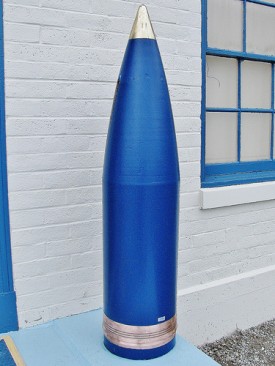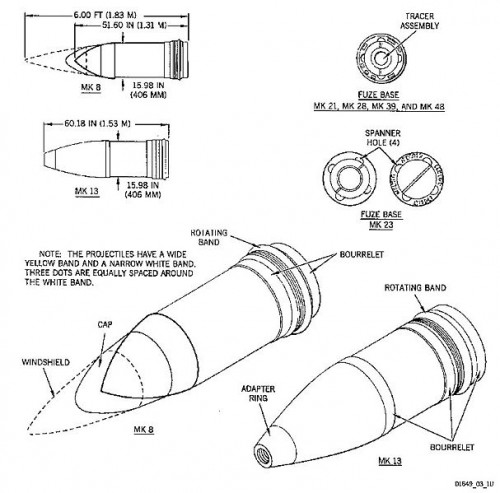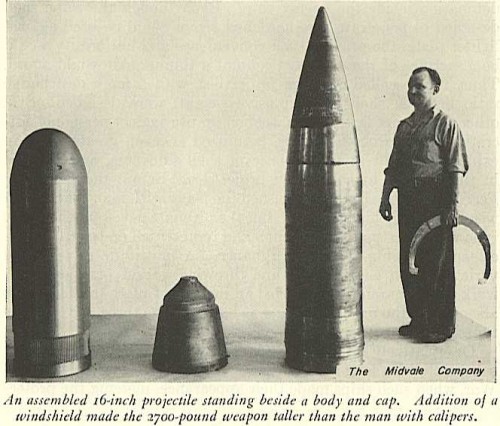Introduction
The previous two blogs looked at the ogive shape and its use in describing bullet shapes. While cruising around the web, I noticed a rather large ogive shape that I thought was interesting. I am a big fan of anything having to do with battleships, and the 16-inch projectiles fired by the Iowa-class battleships are an excellent example of a large ballistic ogive. They have an ogive radius of 9 calibers (i.e. 144 inches/ 16 inches = 9 caliber). For those interested in a modern discussion of these projectiles and how to improve them, I suggest this forum discussion.
Background
During WWII, the Iowa-class ships fired two types of projectiles:
- Mk 13 HC (High Capacity)
A shell designed to carry the maximum amount of explosive. It was used for shore bombardment against "soft" targets. It weighed 1900 lbs. It is shown in Figure 1. - Mk 8 AP (Armor Piercing)
This projectile is designed to destroy structures made of reinforced concrete or armored ships, like other battleships. This projectile weighed 2700 lbs. It is shown in Figure 2.
| Source | Source |
Basic Construction
Figure 4 is a good illustration of the differences between the HC and AP projectiles. Notice how the AP shell is basically a big slug of metal that has a windshield on the front of it to make it aerodynamically friendly.
| Source |
Figure 5 shows the actual pieces of an AP shell.
| Source |
Figure 6 shows a dimensioned drawing of the HC projectile. Note that the fuze, which attaches to the nose, is not shown. The full length of the projectile with fuze is 64.00 inches.
| Source |
To illustrate that these projectiles have 9 caliber ogives, I fitted a couple of 9 caliber radii circles to one of the photos (see Figure 7).
Conclusion
In this post, I showed that even large projectiles use the ogive shape. I collected some useful historical information into a single spot and will use this data in posts to come on ballistics.
Postscript
See Figure 8 for a snippet from a US Navy manual that describes this projectile.

Figure 8: Snippet from 16-inch Gun Range Table. (Source)







Another interesting article (just read your blog on WWII submarine fire control). Do you have references or information on analog fire control carried on WWII Battleships (MK1?) such as the USS Washington?
Hi Fred,
Thanks for reading my blog. There are a number of good references out there. My favorite is "Between Human and Machine". This is a great read. It focuses on surface ship fire control. It covers the encounter between the USS Washington, USS South Dakota, and IJN Kirishima in some detail.
Mindell, David (2002). Between Human and Machine. Baltimore: Johns Hopkins. Appendix A. ISBN 0-8018-8057-2.
I can also HIGHLY recommend "The Dreadnought Project." This has wonderful resources on how surface ship fire control evolved to their WWI level.
http://www.dreadnoughtproject.org/
It is very interesting to see how the fire control systems from WWI evolved to those used in WWII.
Thank you for your service. I am an engineer who had the privilege of working with and for a number of submarine officers. They were all good men.
Mathscinotes
Do you have a list of armor ratings for shore-based targets? ie, 1" of steel armor = ?" of reinforced concrete = ?" of regular concrete = ?" of dirt.
I have never investigated the topic of defensive armor. I know the battleship designers of old had rules that they followed for protection against shells and torpedoes. Here are a couple of docs from the US government that might provide you some interesting thoughts:
FEMA 453: document on building ballistic resistant structures.
Appendix on the effects of weapons (another government doc).